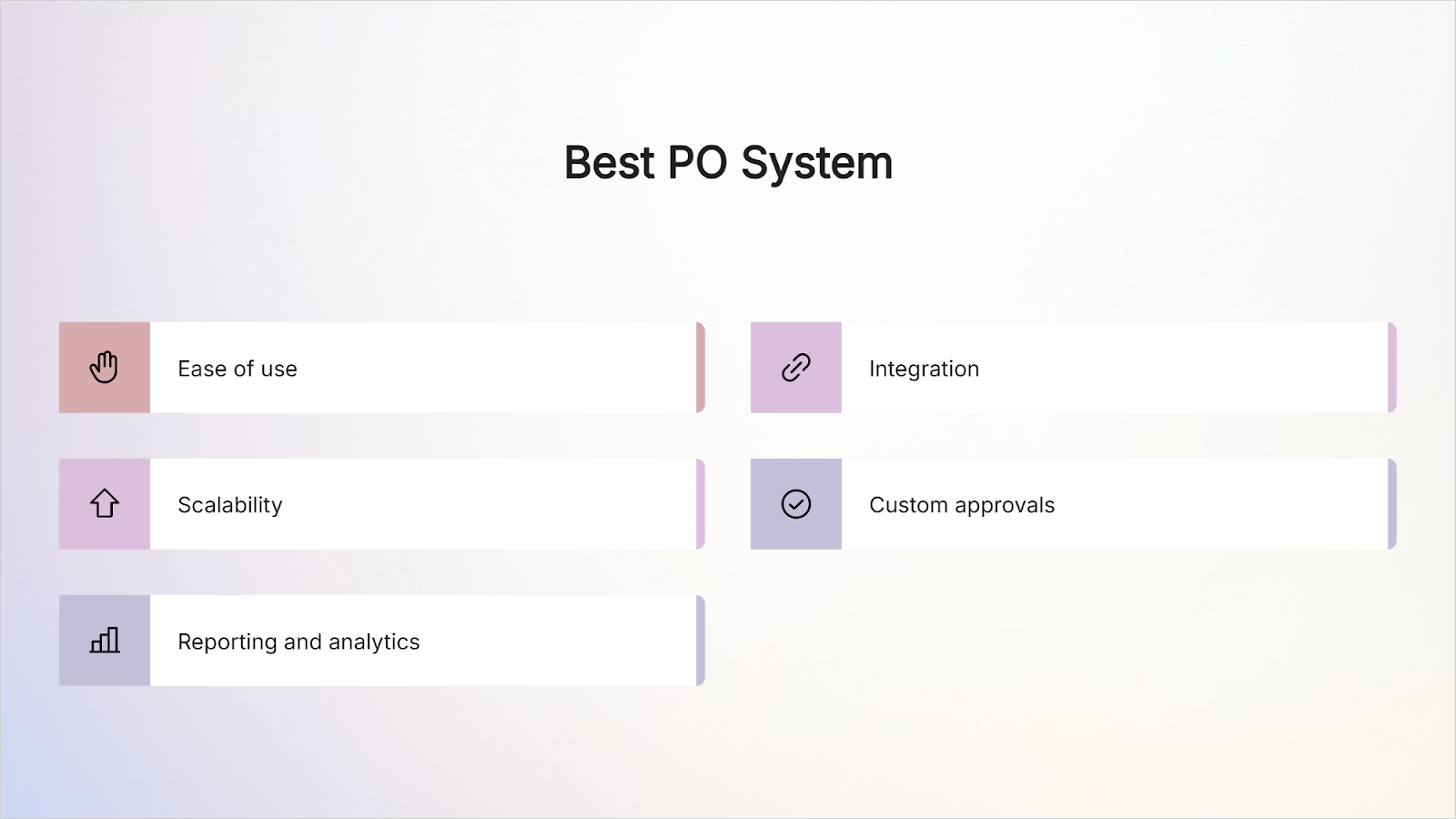

Healthy Purchase Order (PO) Systems: A Comprehensive Guide
%20Systems%20A%20Comprehensive%20Guide.webp)
Healthy Purchase Order (PO) Systems: A Comprehensive Guide
Learn how a healthy PO system streamlines procurement, automates approvals, reduces costs, and enhances financial visibility and control.
%20Systems%20A%20Comprehensive%20Guide.webp)

The consulting firm Boston Consulting Group reported in its analysis that companies that have transitioned to use a dedicated purchase order system, as opposed to manual PO processes, can realize a reduction of up to 10 percent in cost and a reduction in procurement processing time of up to 30 percent.
A healthy PO system assists teams with keeping track of expenditures, reducing manual data entry, and making all purchases subject to the appropriate approval workflow and compliance policies. Nevertheless, many businesses still handle purchase orders through email chains or spreadsheets. Such an arrangement frequently results in mistakes, maverick spending, expired renewals, and cost overruns.
What Is a PO System?
A purchase order (PO) system is a solution used to prepare, authorize, transmit, and monitor purchase orders between suppliers and customers. It ensures that every purchase requisition and purchase request is checked, granted, and recorded before payment, aligning with company payment terms and regulatory compliance.
How Do You Set Up a Healthy PO System?
One of the best methods to ensure procurement is well organized and compliant is to establish a powerful purchase order (PO) system. In the case of expanding tech firms, the structure can be seen to facilitate teams to work quicker, operate inside of budgets, and have a total view of how the company spends their money. This is how to create a purchase order system that expands as your business expands.
1. Define the workflow
The first step is to determine the owner of each stage of the purchase order process. Determine which teams are authorized to make requests, who accepts them and who gets the goods/services. As a result of clear ownership, there will be accountability and fewer unnecessary or duplicate purchases.
2. Standardize templates
Adopt standard purchase order format throughout the departments. Add the key fields to include the vendor information, PO number, item information, quantities, unit costs, and total price. The use of a standardized template assists the teams to keep things straight and ultimately allows the finance to be able to match POs and invoices in the future.
3. Assign approval rules
Establish definite limits of approval depending on department or spending limits. The purchases of lower value might only require a single level of approval and bigger purchases should be taken through finance or senior management. Prescribed regulations discourage bottlenecks and maintain financial control.
4. Connect with accounting or ERP systems.
Link your PO system to accounting or ERP software to maintain all financial data in harmony. With integration, purchase orders can be directly linked to budgets, payment, and inventory. This minimizes manual entry errors and provides finance with a real time view of committed spend.
5. Train your team
Give practical training on the creation, approval, and the tracking of purchase orders in order to ensure that everyone knows how to do it. Employees will be more inclined to adhere to the process correctly and to prevent any delays or compliance problems when they understand the process and why it is necessary.
6. Monitor and refine
Review the system after implementation. Look for errors in terms of missing data, approvals that are late, or duplication. Audits and user feedback will keep the process efficient and business-oriented.
A properly designed or healthy PO system helps eliminate confusion, avoid unnecessary spending, and provide finance leaders with superior control over budgets. Growing organizations can easily use tools such as Spendflo since it automates PO creation, approvals, and it integrates procurement data into finance systems in a single location.

Benefits of an Automated Purchase Order System
A purchase order system is automated, which sends a previously slow, tedious process into a rapid, digital process. Automation saves time, enhances accuracy, and provides finance and procurement departments with a better insight into each purchase. These are the major advantages of transitioning to automated PO.
1. Faster approvals
Through automation, requests are sent to the appropriate approver minus manual follow-ups. This reduces the approval cycles and keeps the procurement going, at the same time when there are several departments involved.
2. Fewer errors
Duplicate or incorrect PO can hardly happen, with automated data entry and validation. The system makes sure that every detail is fulfilled before it is submitted to eliminate costly errors.
3. Better visibility
Real time dashboards are displayed that indicate the status of all POs, those awaiting approval or approval, as well as those done. This assists the procurement and finance departments to track the progress of spending and notice bottlenecks fast.
4. Tighter budget control
Automation enforces rules of the budget automatically, and it eliminates unauthorized or duplicate purchases. Financial discipline can be enhanced by allowing teams to look at the overall budget and understand how each PO will impact it.
5. Audit readiness
All POs, approvals and changes are registered in the system and leave a complete audit trail. This simplifies the relevance of compliance and prompt reaction to internal or external audits.
6. Better relationships with vendors.
Purchase orders are accurate and timely, which will result in the communication being streamlined and quicker. Vendors like having expectations and receiving payments quickly, which enhances long-term collaborations.
A healthy PO system is one in which routine activities are automated leaving your staff to concentrate on strategy, negotiation, and supplier performance and not on paperwork.
What Is the Best PO System?
Your size of company, volume of spending, and technology installation would determine the best purchase order system. The perfect option makes the work of employees easier and provides the finance department with complete visibility and control over expenditure. These are the main features to be considered when appraising PO systems.
1. Ease of use
Select a system that has a clean and intuitive interface which any member of the company will be able to use including people who are not in the financial department. The easier POs are to prepare and authorize the more frequent its usage is going to be.
2. Integration
Your PO system must integrate well with the current systems such as ERP platforms, accounting systems and vendor management systems. Integration ensures the consistency of data and minimizes manual reconciliation.
3. Scalability
Choose a platform that will expand with your organization. The system in question should be able to support increased transactions and approvals without reducing performance as the list of vendors and budgets grows.
4. Custom approvals
See software that can be configured to permit the flexibility of approvals depending on departments, roles or amount of spending. This makes sure that the right people are made to sign on the right purchases without any unnecessary delays.
5. Reporting and analytics
Powerful analytics will enable you to monitor expenditure by department, vendor, or category. These reports assist in the identification of trends, reporting on performance, and making smarter decision-making on budgeting.
A purchase order system is not just a good system that accepts forms, but it establishes a base on higher financial control, transparency, and cooperation.

Building a Healthy Purchase Order System with Spendflo

Streamlined procurement and stable financial control are based on a healthy purchase order system. In case companies have no centralised controls and real time visibility, they usually suffer fragmented approvals, unnecessary expenditures and no idea of vendor commitments. During our collaboration with Acumatica, Spendflo assisted the company in integrating procurement workflows among the teams, avoiding duplication of the software stack, and saving over $375,000 and creating a single perspective on spend and vendor contracts.
Through the platform used at Spendflo, the purchase-order lifecycle is transparent, efficient and audit-ready. All requests, approvals, and payments are recorded in a single system, which gives the finance and procurement teams dashboards that demonstrate the precise movement of money and risk locations. Consequently, organisations move away to ad-hoc, manual PO workflows to organised procurement operations that enable both growth and cost control simultaneously. Willing to make your PO system work extra hard? Book a free Demo with Spendflo today.
Frequently Asked Questions
1. What are the 4 types of PO?
There are four categories of purchase orders, namely Standard, Blanket, Contract, and Planned. One-time purchases that have set specifications are done using a Standard PO. A Blanket PO is used to order repetitive orders that are less definite in their delivery dates. A Contract PO is a long-term agreement, but with no specified items whereas a Planned PO is a requirement known to be delivered in the future.
2. What is the best software for purchase orders?
The purchase order software that suits well depends on the size of your company, workflow, and integration requirements. Increasingly, firms look to Spendflo to automate PO generation, approvals, and budgetary monitoring in a single system. The appropriate software must be simple to use, integrate with your accounting or ERP software, and provide you with a clear view of your spend and vendor actions.
3. What are the 5 P’s of purchasing?
The 5 Ps of buying include Price, Product, Place, Promotion and People. They determine the manner in which firms make buying decisions. These categories are Price, which puts attention on the cost and value, Product, which is considered to be of quality and suitable, Place, which is the logistics and delivery, Promotion, which is the relationship with suppliers and the last category, which is people, the teams in charge of procurement. These factors can be balanced to make organizations attain efficient and cost-effective purchasing.
4. What is the difference between a PO and a purchase order?
PO is not different from a purchase order. PO is merely the short form of purchase order. They both denote the professional document a buyer provides to a supplier to make a request to be supplied with goods or services on agreed terms. The document contains the information about items, their price, quantity and terms of payment, which is a legal and financial document of both sides.










.png)




.png)




%20Questions%20to%20Ask%20Vendors.webp)





.avif)





